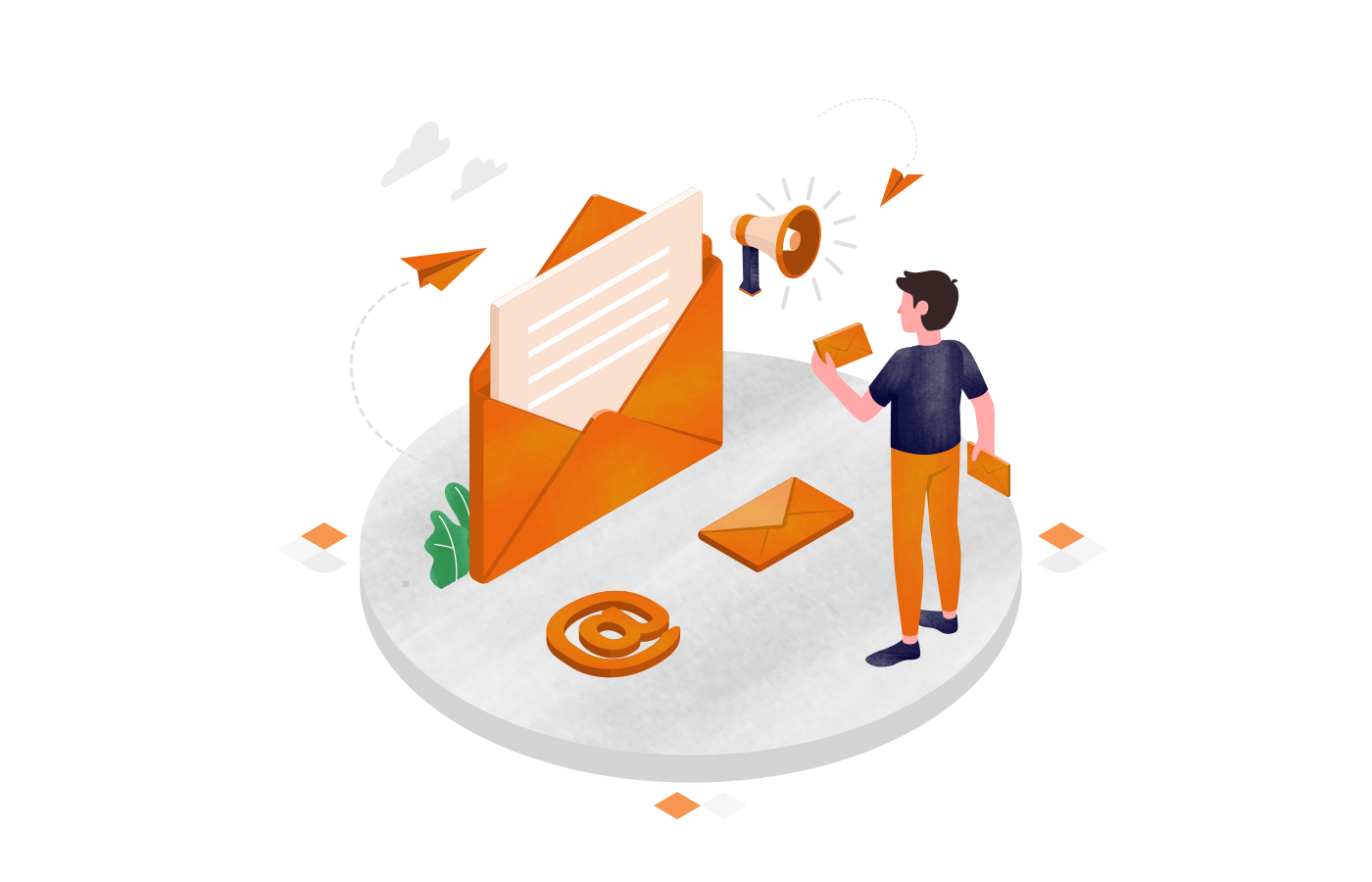There’s a reason why 90% of businesses are turning their heads toward an email marketing strategy. It has an average Return on investment (ROI) of 3600%. When done right? Over 7000%! While surprising, these numbers are also highly obtainable.
So, what do excellent email marketing campaign examples look like? How do you create a successful email marketing campaign? You’ll find answers to these questions and more here! Keep reading!
What is an Email Campaign?
Email marketing involves sending different emails to your audience or subscribers. Each email is part of an email campaign.
An email campaign includes a series of emails designed with a specific goal. These can be automated (known as autoresponder sequences) or sent as regular email newsletters.
What are the goals of email marketing campaigns? Education, entertainment, or a mix of both. When executed well, these campaigns help you build stronger relationships with subscribers, boost customer loyalty, and promise higher conversions.
Types of Email Campaigns
Email campaigns come in various forms, each designed to serve specific purposes and engage recipients at different stages of their customer journey. Let’s take a look at the most common types, plus real email marketing campaign examples:
Welcome Emails
Welcome emails are the first interaction a subscriber has with your brand after signing up for your newsletter.
Here’s a successful email campaign example by Bubble:
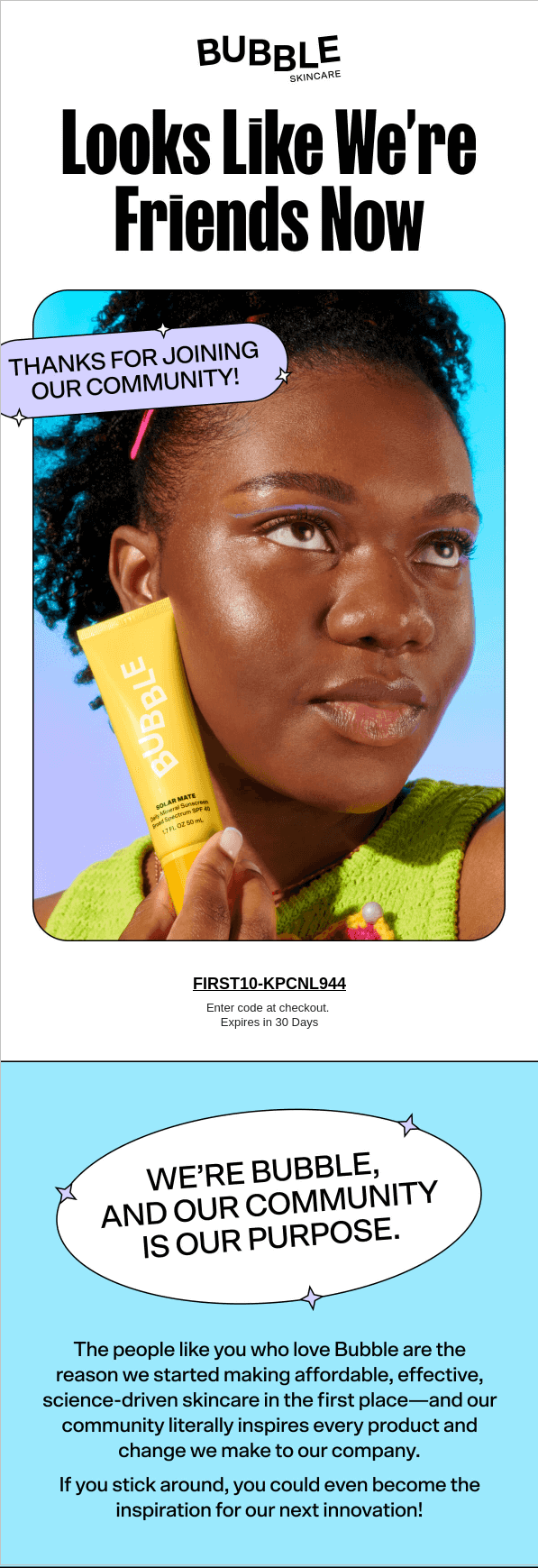
A friendly welcome email makes a customer feel valued and appreciated. Plus, they’re generally sent to:
- Confirm subscription and set expectations;
- Introduce your brand and value proposition;
- Provide a special offer or incentive to encourage engagement;
- Guide subscribers on the next steps or how to get started.
Newsletter Campaigns
Newsletters keep your audience informed and engaged with your brand. You can use them to announce new products or share exclusive offers.
Here’s an interesting newsletter campaign by Hux:
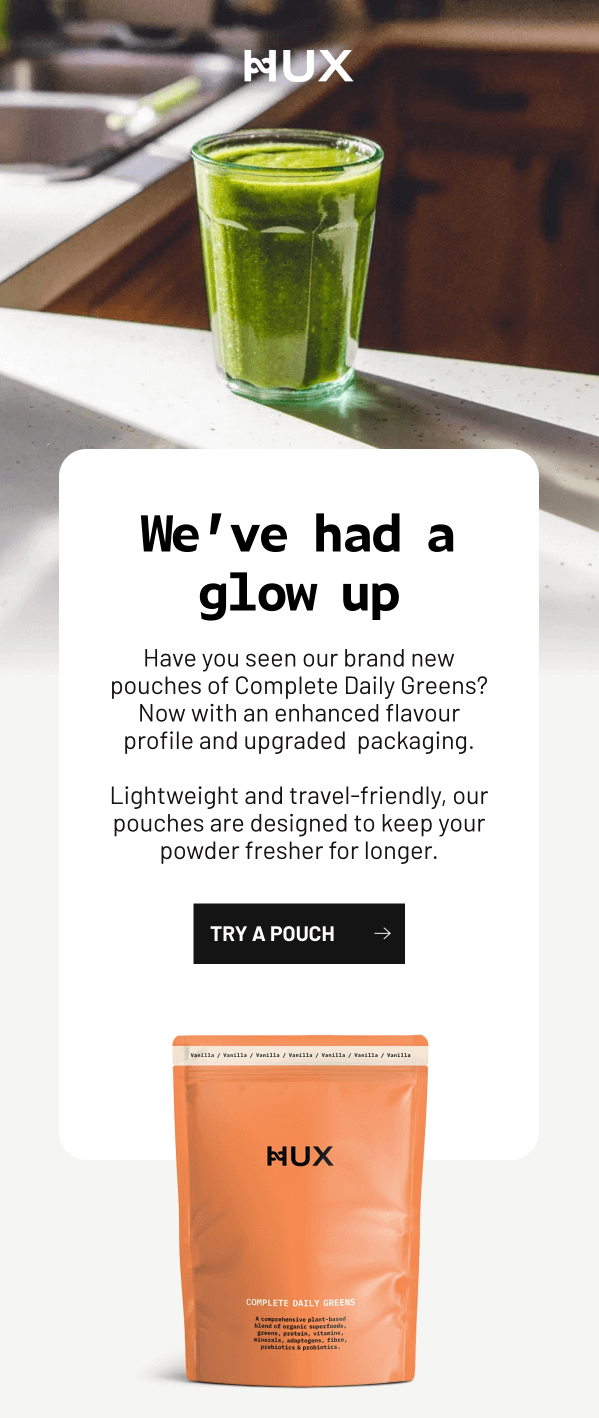
Newsletters can be used for:
- Sharing company news, updates, and industry insights;
- Sharing content that educates or entertains subscribers;
- Driving traffic to your website or blog post.
Create email campaigns without spending long hours designing them. Use readymade email templates and drag-and-drop builder, and it’ll be a breeze.
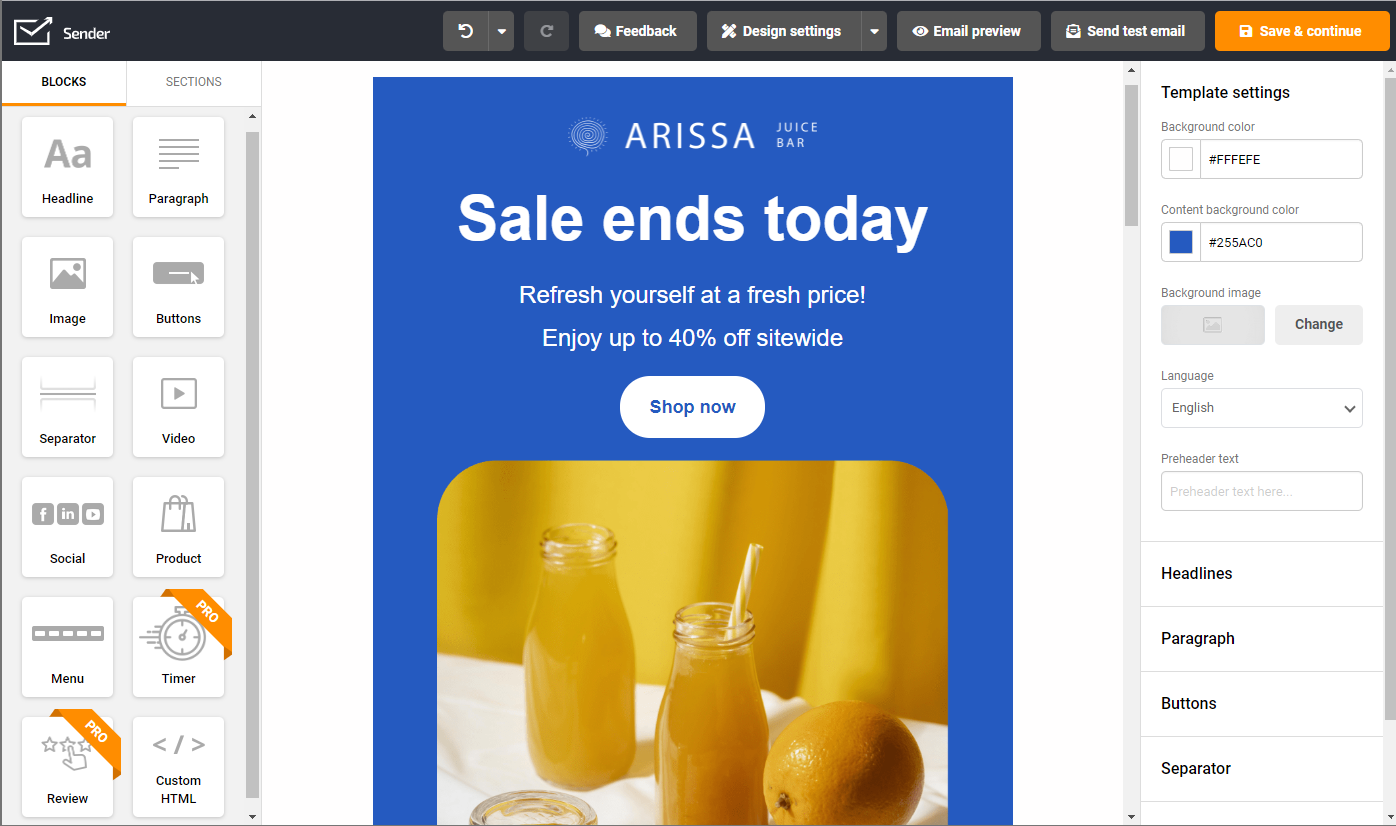
Promotional Emails
Promotional emails drive sales by highlighting specific products, or special offers. They are sent to encourage immediate action. Here’s how GoPro uses promotional emails to bump up conversions:
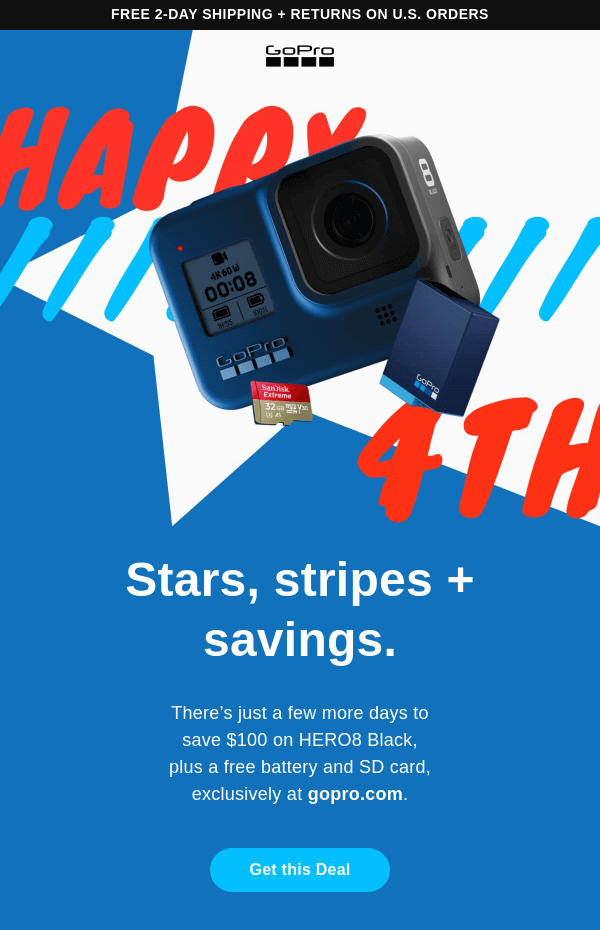
Just like GoPro, you can send promotional email campaigns to:
- Announce sales, discounts, or special offers;
- Launch new products or services;
- Boost sales during specific periods like holidays;
- Re-engage inactive customers with exclusive deals.
Automated Emails
Automated emails, also known drip campaigns, are sent automatically based on specific triggers or customer actions using modern email marketing tools.
For example, here’s an automated email sent by Sundays after a purchase, asking customers to leave a review:
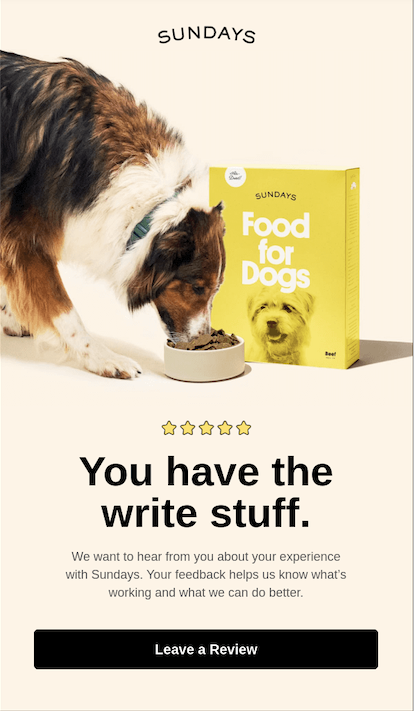
Such kind of automated emails boost your marketing efforts phenomenally while reducing manual tasks.
You can set automated emails to:
- Onboard new customers or users;
- Nurture leads through the sales funnel;
- Re-engage dormant subscribers or customers;
- Provide personalized offers based on their interests/past actions.
Transactional Emails
Transactional emails share important information regarding the account, orders, or any action taken on the website. For example, order confirmation, shipping confirmation, etc.
Here’s a great example of a transactional email by Ritual:
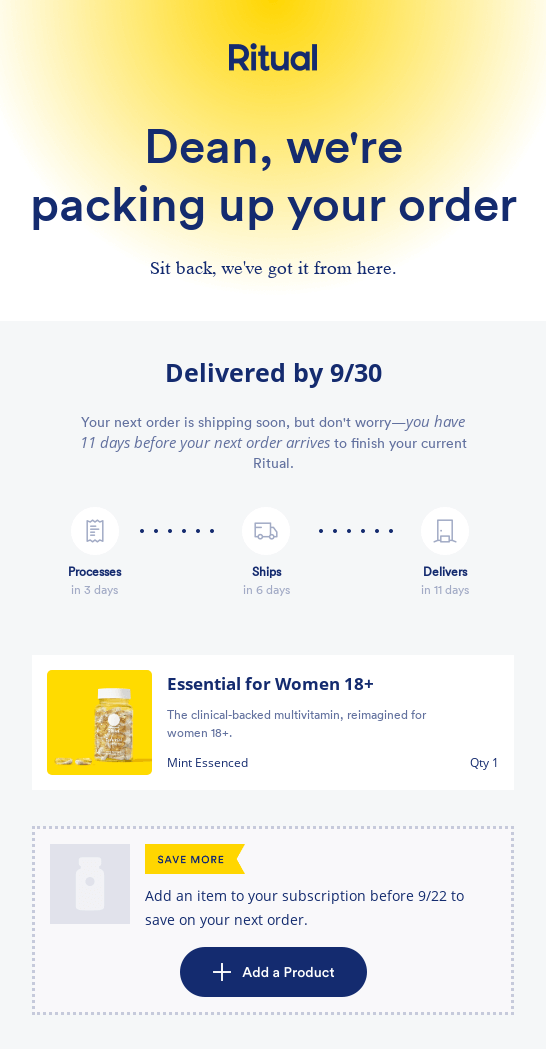
As a marketing manager, you should also plan similar emails. Make sure to:
- Personalize your email subject line for grabbing attention;
- Use clear and simple language to pass on the important information;
- Use a visually appealing design.
Running a Successful Email Marketing Campaign
So, you’re thinking about using email to reach your audience? Good call! Email is a direct line to your interested contacts, and when done right, it can be the key ingredient in a successful email campaign.
But beware, a bulk email campaign without a strategy is like throwing spaghetti at the wall and hoping it sticks (messy and ineffective).
Here’s how to serve up effective email marketing campaigns that leave your audience wanting more:
Get to know your audience
Before you even think about crafting your masterpiece of an email, you need to know who you’re talking to. What are their interests? What problems do they need solutions for?
This is where email segmentation becomes your best friend. By dividing your targeted email list into smaller, more specific groups, you can send personalized email messages that resonate.
Write content that clicks
You’ve got their attention – now what? Your email content should be clear, concise, and valuable. Remember, no one wants to wade through a wall of text. Use headings, bullet points, and images to break up your message and make it easy on the eyes.
Make your emails look amazing
We eat with our eyes first, and email is no exception. Just like you wouldn’t send a plain white birthday card, your emails should be visually appealing. Thankfully, many email service providers offer email campaign templates that make designing a responsive email design a piece of cake.
Add a call-to-action that stands out
Don’t leave your readers hanging! What do you want them to do after reading your email? Make it crystal clear with a strong call-to-action. Whether it’s “Shop Now,” “Learn More,” or “Sign Up Today,” a clear and concise call to action is essential for any successful email campaign.
Keep an eye on your results
Sending out an email campaign is only half the battle. Campaign analytics, such as your email open rate, will tell you what’s working and what’s not.
This valuable data allows you to refine your approach, test different elements, and ultimately create an even more successful email campaign that contributes to encouraging customer loyalty.
Effective Email Marketing Campaign Examples
Now you’ve explored the different email marketing campaign types and components, you will relate better to the real examples of successful email marketing campaigns. Here are some great marketing emails by global brands:
Thank You Emails — Wonder Valley
Showing gratitude is a nice way to nurture a long-term relationship with your audience. So, you should plan thank you emails from time to time. It needn’t be long, but it should be sincere, just like this email by Wonder Valley:

The email features a personal note from the founders, making it really human. The mention of a special playlist for celebrations is a nice add-on to show they’ve actually made an effort. It also comes at the perfect time, when everyone loves receiving a heartfelt gratitude.
Why it works?
- Personal tone with an unexpected gift – a curated playlist;
- Holiday vibes in the header image;
- Perfect timing, right before Thanksgiving.
Seasonal Email — Lululemon
Seasonal email campaigns are great for engaging users during the holidays or summer, especially when you’ve relevant offers or products.
Seasonal email campaigns should be contextual and geared towards selling seasonally relevant products or services—for example, warm clothes during the holiday season. Look at the following example by Lululemon:

The email is sent during the winter when everyone appreciates cozy joggers and winterwear. The timing of the email, the warm vibe, and the relatable email copy make it a tremendous seasonal email campaign.
Why it works?
- Relatable and witty copywriting;
- Great and contextual offer, relevant to the reader;
- Warm color tones and photography.
Educational Emails — Dollar Shave Club
Educational emails are sent to create awareness about a product, offer, use case, or application. They’re generally sent to subscribers who are likely to buy a product. Dollar Shave Club sends several educational emails about the benefits of its products. Here’s one:

The email is an interesting take on educational emails, which often come with long walls of text. Instead, they’ve used a catchy infographic, followed by a short paragraph that explains why it’s a good idea to put on sunscreen.
There’s a product and reviews placement right after educational section addressing apprehensions and enticing readers to move further towards checkout.
Why it works?
- Crisp and concise communication;
- Eye-catching header infographic;
- Relevant product and review blocks.
Feedback & Survey Emails — J.Crew
Listening to the voice of your customers is essential for any business. So, why not send periodic feedback email campaigns to existing customers?
Specialty retailer J.Crew has an interesting strategy, where they follow up after a purchase with a minimal feedback email. Have a look:
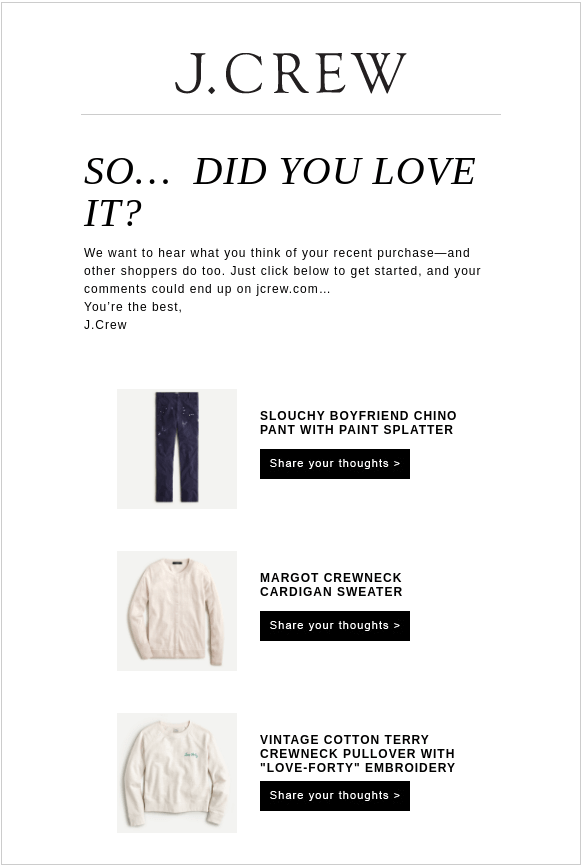
The email is minimalist and gives direct CTAs to users to share their opinion about their recent purchases. The writing is direct and impactful. There’s no extra element in the email, which reduces distraction and directs readers to the review page.
Why it works?
- Minimalist design with zero distractions;
- Contextual and relevant ask about past purchases;
- Direct CTA buttons asking to share thoughts.
Nurturing Emails — Wix
Nurturing emails are sent to nurture prospects, influence them to buy something, or even aim at inactive prospects or customers who have not engaged with your brand for some time now.
The key purpose is to move them further into the buyer’s journey and make them buy something from your store. Here’s an example from Wix:
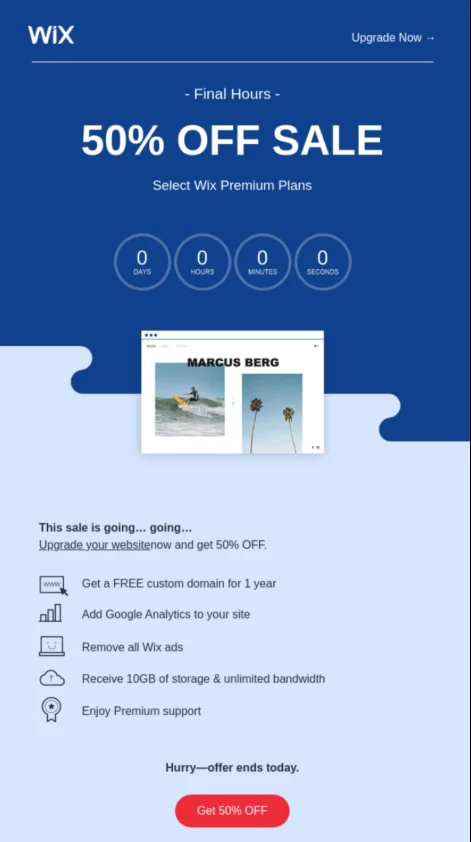
Wix used the special sales offer as a reason to nurture inactive or trial users to convince them to upgrade to a paid plan. Nurturing emails is a great way to break the ice, address apprehensions, or entice them, as Wix did with their email campaign.
You can consider sending re-engagement emails as we miss you emails as a reactivation or nurturing attempt before segmenting a subscriber or trial user into your churn list.
Why it works?
- Great offer, addressing the price apprehension to upgrade;
- Countdown timer, adding a sense of urgency to act.
Find out more useful tips on this guide: Getting Email Nurturing Right: Campaign Success Tips
Abandoned Cart Emails — Luxy Hair
Cart abandonment is a big problem for the ecommerce industry. According to the most recent estimates, 57-84% of carts are abandoned across different industries. This translates to massive losses for ecommerce businesses.
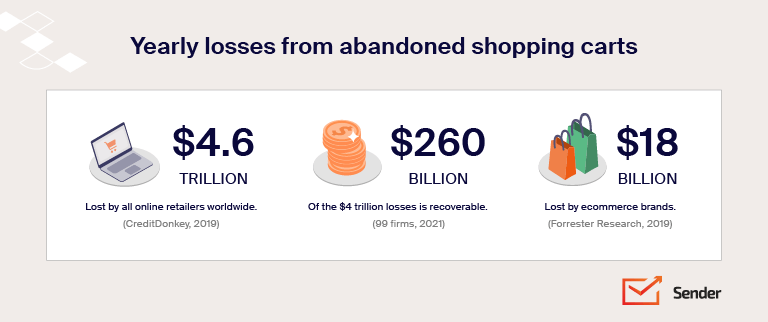
Automating a cart abandonment email can be profitable to win back your customers and increase your sales revenue. Here’s an interesting cart abandonment email template example by Luxy Hair:
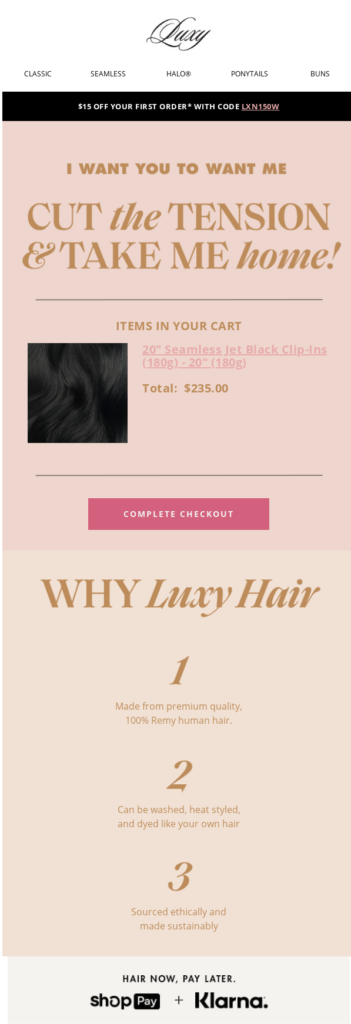
This interesting email is an excellent attempt to return the shopper’s attention to the Luxy Hair store. The witty one-liners in the header with a bold CTA button to complete checkout is enough to convince them to give their pick a second thought.
Why it works?
- Witty copywriting in the header;
- Clear reasons to rethink the purchase as a separate block;
- Special ‘buy now pay later offer within the email.
Birthday & Anniversary Emails — L’Occitane
Who doesn’t like birthday or anniversary wishes? Well, your subscribers sure do. Running a birthday or anniversary email campaign is a great way to tell your subscribers you care. You can share special offers, gifts, or samples as birthday gifts. Here’s a great example by L ‘Occitane:
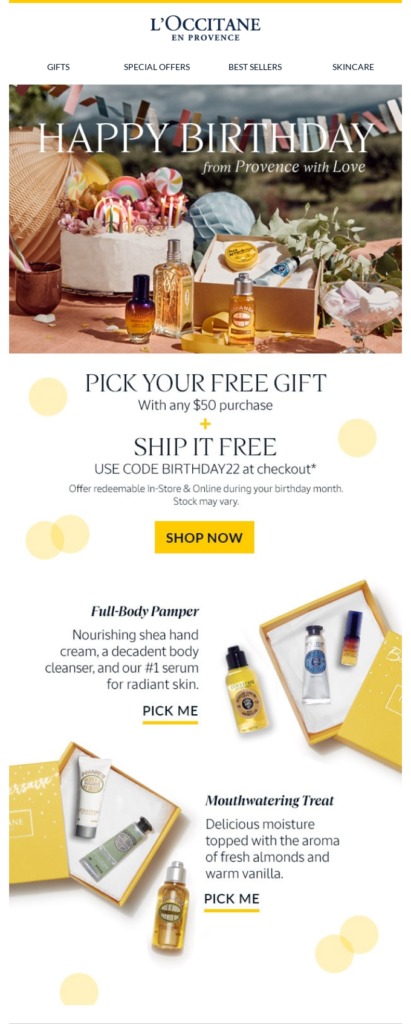
The email warmly wishes the subscriber and offers a gift for every birthday purchase. The beautiful design and a valuable offer will show the recipient that the brand has really considered sending this wish. Plus, the contextual recommendations are a cherry on top.
Why it works?
- Free gift and shipping offer on birthdays;
- Contextual shopping recommendations based on buyer’s likes and dislikes;
- Cheerful and celebratory email design.
Promotion Email — beats
Promotional emails announcing special offers are nothing new in the industry. In fact, most brands send multiple promotional emails every month. Here’s an example by beats:
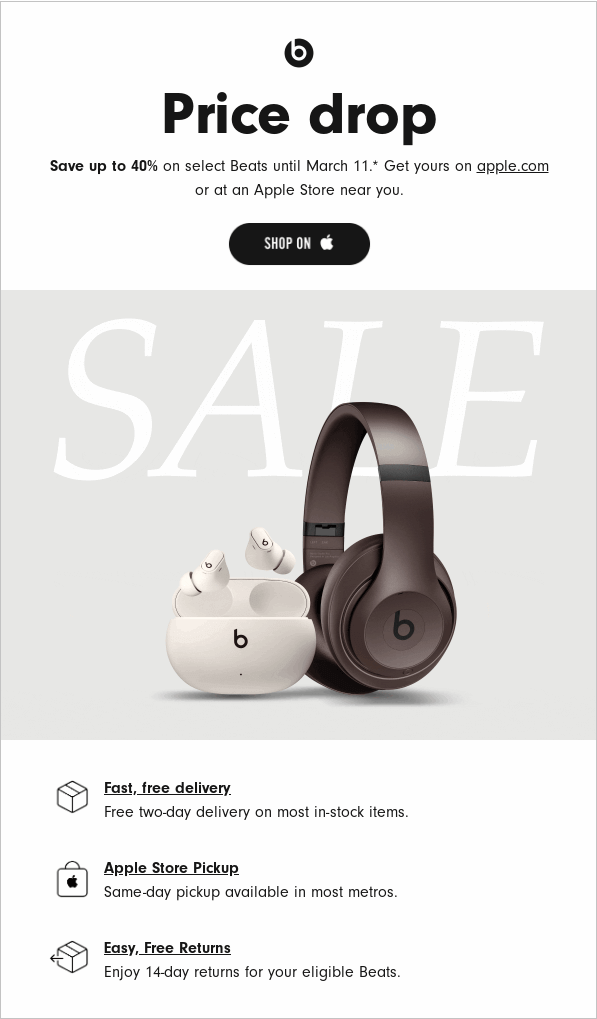
This minimalist email has a promising header announcing a price drop on their popular product. High-quality product images and relevant bullet points make the offer stand out.
A subtle hint of urgency is evident with the mention of a last date, which would’ve made recipients click on the CTA button.
Why it works?
- Minimal and clean design;
- Clear offer with mention of a last date;
- Bullet points promising convenience for shoppers.
Drip Campaign — Pulp & Press
Drip email campaign is a series of automated emails sent to subscribers who perform an action on your website.
They’re triggered by an email marketing software in pre-defined sequence to improve the user experience, follow-up, or provide important information. Sometimes, brands create post-purchase drip campaigns to appreciate & inform customers, like Pulp & Press:
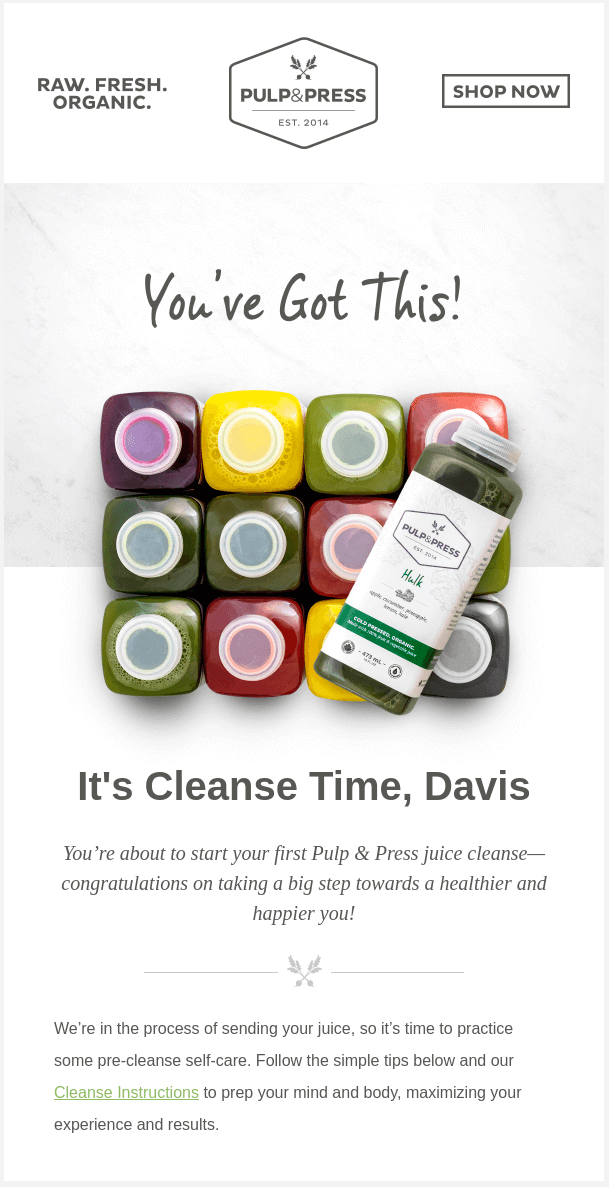
This targeted campaign email is sent to shoppers who’ve placed an order. It reassures them about the order and shares specific instructions on how to use the product effectively.
Use of an eye-catchy product image and a motivating tone would make the reader anticipate for the delivery eagerly.
Why it works?
- Automated sequence at the right moment;
- Use of contextual and valuable information;
- Reassuring tone in the email copy.
Re-engagement Emails — Freshly
Re-engagement campaigns are sent to inactive users who have bought from you in the past, but haven’t engaged recently. The goal of such campaigns is to encourage them to act instantly.
For example, here’s a successful email campaign by Freshly:
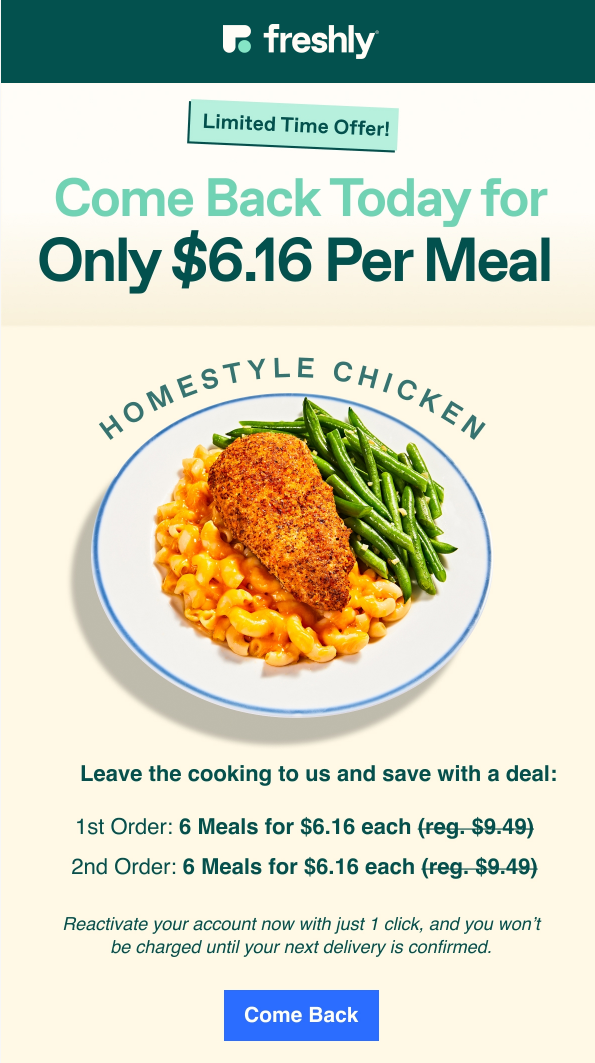
The email is sent to customers who’ve not ordered in a long time. The interesting and rewarding limited-time offer is a sure way to re-engage and win back lost customers.
The subject line for this email — ‘Get $6.16 Dinners When You Come Back, Fam!’ is intriguing enough to make someone open the email.
Why it works?
- Contextual offer sent at the right time;
- Engaging hook (subject line) topped with a valuable offer;
- Simple yet powerful CTA button prompting the user to give the brand a second chance.
Key Components of an Effective Email Campaign
An email campaign consists of several important elements, which, when combined, create the desired impact. Let’s look at the different components of an effective email campaign and see how you can nail them.
- Subject line. It’s the deciding factor for your email’s performance and your first opportunity to make an impression on your subscribers;
- Preview text. Preview text appears alongside the subject line and provides additional context to entice recipients to open your email;
- Personalization. Personalization involves customizing your emails per subscriber’s preferences, interactions, or interests to make emails more relevant and targeted.
- Call-to-action (CTA). Call-to-action is the specific action you want your recipients to take after reading your email and is detrimental to driving conversions;
- Design and layout. Design plays a vital role in engagement. So, choose email campaign templates with a responsive and clean design that enhances readability and guides readers toward your CTA;
- Segmentation. Segmentation involves dividing your email list into smaller groups for personalizing your email campaigns.
Send Stunning Email Campaigns with Sender
Tired of email service providers that promise the world and deliver a whole lot of nothing? You deserve an email campaign software that helps you stand out!
Sender provides everything you need to create successful email marketing campaigns that capture attention and drive results. We’re talking about sleek designs, human-friendly tools, and features that make managing bulk email services a breeze.
But wait, there’s more! Sender offers a library of professionally designed email campaign templates to make your life easier. Whether you’re sending a welcome message, promoting a sale, or sharing a company update, you’ll find a template that fits the bill.
And the best part? Sender makes crafting and sending beautiful emails a straightforward process with an intuitive drag-and-drop builder.
Plus, with the free forever plan, you can send up to 15,000 emails monthly to 2,500 subscribers – no credit card required. That’s right, you can experience the power of Sender completely free!
All the email marketing features, none of the struggles. Create, automate, and grow your audience with Sender — no tech skills required!
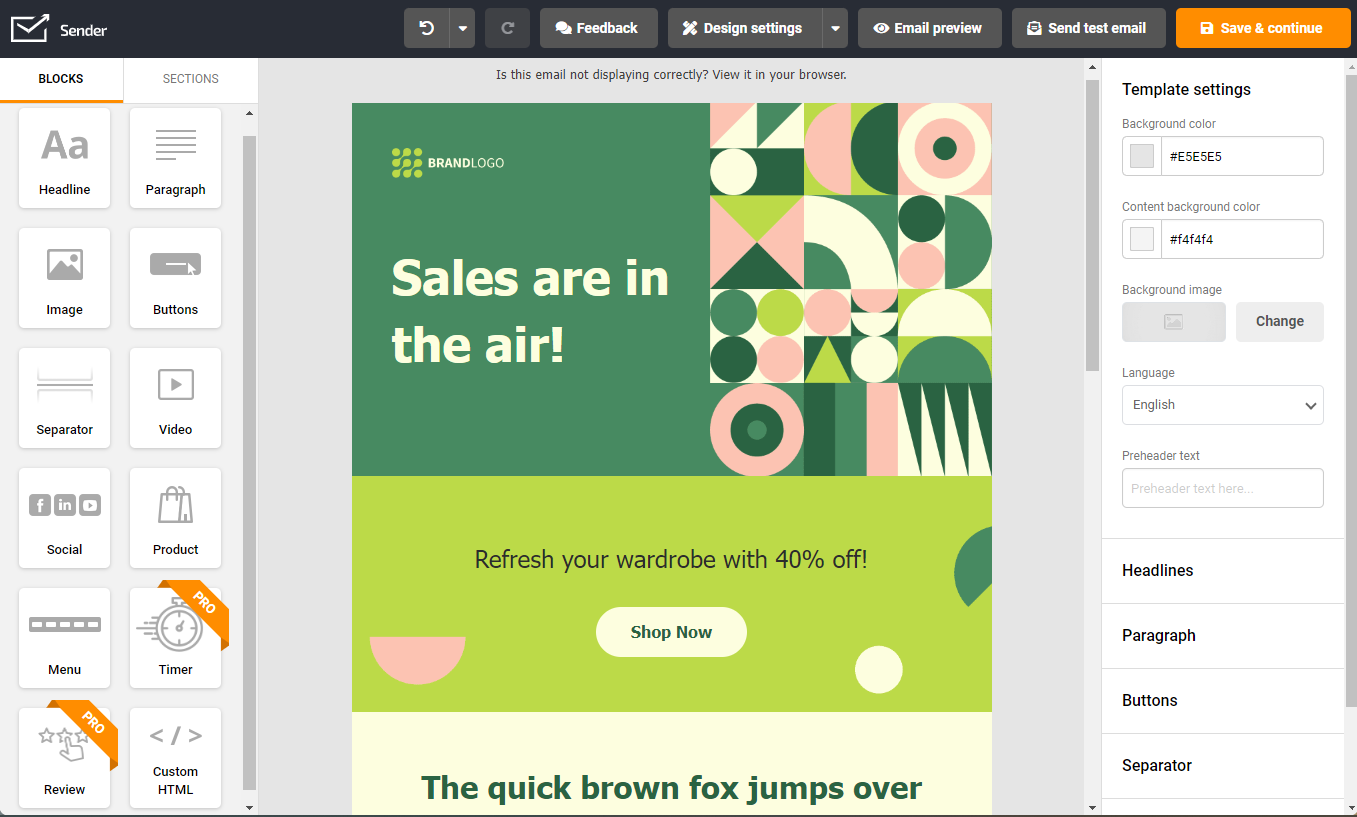
Some other top-notch articles worth your attention:
